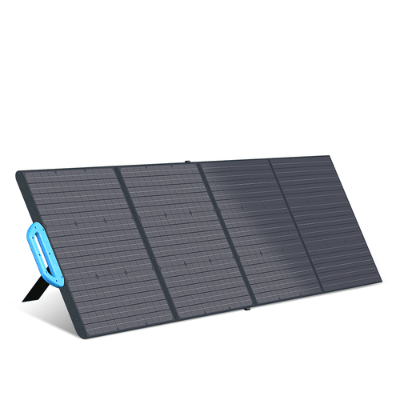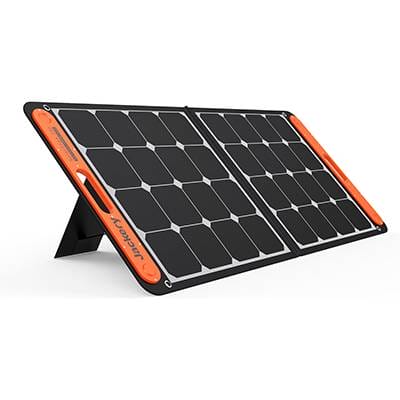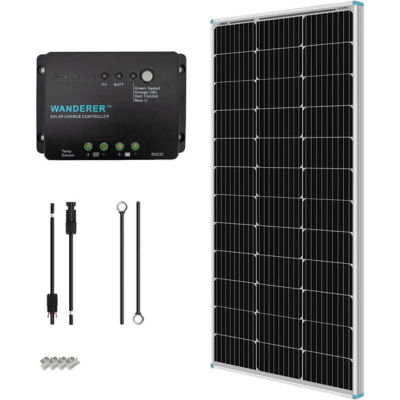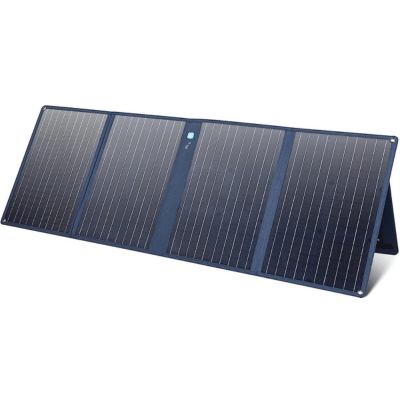You want a portable solar panel—but as soon as you start looking, you’re bombarded with specs. Wattage, efficiency, monocrystalline vs. polycrystalline, rigid vs. foldable… and then there’s talk of inverters, charge controllers, and connectors.
It’s overwhelming.
But here’s the thing: not all features actually matter in real-life scenarios.
If you’re camping, RVing, or prepping for emergencies, the best portable solar panel isn’t necessarily the one with the highest wattage or the most expensive tech. It’s the one that works when and where you need it most.
In this guide, we’ll break down what really makes a good portable solar panel—from panel types and wattage requirements to practical use cases. We’ll also cover setup tips, maintenance hacks, and how to figure out how many panels you actually need (spoiler: one might not be enough).
And if you care about the environment (which you probably do), we’ll also highlight five of the most eco-friendly portable solar panel brands to help you make a greener choice.
Let’s get started.
Which Portable Solar Panel Type Is Best for You?
Not all portable solar panels are built the same—and what works for an RV or off-grid cabin might not be the best choice for camping, hiking, or beach outings.
Before you invest, you need to match the panel type to your specific power needs.
1. Foldable Portable Solar Panels – Best for Versatility
💡 Example Models: Bluetti PV200, SolarSaga 200W
Foldable solar panels, typically ranging from 100 to 200 watts, are the best all-rounders. They strike the perfect balance between portability and power, making them ideal for:
- RVs and campervans – Easy to store and reposition
- Off-grid cabins & boats – High-efficiency cells with compact designs
- Camping & tailgating – Lightweight yet powerful enough for charging gear
2. Rigid-Frame Compact Solar Panels – Best for Durability
💡 Example Models: Renogy 100W, Eco-Worthy 195W
Rigid-frame panels come with pre-drilled holes, making them easy to install on roofs, walls, or fixed mounts.
Their sturdy aluminum frames offer:
- Long-term installation – Best for people who don’t want to move their panels around
- Higher efficiency – Less wear and tear compared to foldable models
- Off-grid homes & stationary setups – Works well with solar power stations
3. Ultralight Foldable Solar Panels – Best for On-the-Go Charging
💡 Example Model: Anker 625
For adventurers who want solar power anywhere, ultralight panels are designed for maximum portability.
These are perfect for:
- Hiking & backpacking – Small enough to fit in a rucksack
- Beach parties & picnics – Lightweight and easy to set up
- Car emergencies – Keep one in your trunk for backup power
Most ultralight panels come with built-in USB ports and plenty of eyelets, so you can strap them to a tent, backpack, or even a kayak while charging your devices directly.
Monocrystalline vs. Polycrystalline vs. Thin-Film: Which Portable Solar Panel Is Best?
When shopping for a portable solar panel, you might assume size and wattage are all that matter. But the type of solar cell inside can make a huge difference in efficiency, durability, and long-term performance.
Most high-quality portable solar panels use monocrystalline solar cells, known for their high efficiency and longevity. However, you’ll still find polycrystalline and thin-film panels on the market—each with its own pros and cons.
1. Monocrystalline Solar Panels – Best for Efficiency & Longevity
Monocrystalline panels are made from a single crystal structure, making them the most energy-efficient option.
They perform better in low-light conditions and last the longest, making them the best choice for portable solar power.
2. Polycrystalline Solar Panels – Cheaper, but Less Efficient
You can recognize polycrystalline panels by their blue hue and visible grainy texture.
Since they are made by melting multiple silicon fragments together, they are less efficient than monocrystalline panels and tend to lose performance over time.
3. Thin-Film Solar Panels – Flexible, but Least Efficient
Thin-film solar panels are made by depositing a photovoltaic layer onto plastic or glass, making them ultra-flexible.
They were once considered cutting-edge, but compared to modern monocrystalline panels, their low efficiency and shorter lifespan make them a poor choice for long-term use.
| Feature | Monocrystalline | Polycrystalline | Thin-Film |
|---|---|---|---|
| Efficiency | 20%+ (highest) | 15–17% | 7–10% (lowest) |
| Lifespan | 25–30 years (longest) | ⏳ 25–30 years (but degrades faster) | 10–15 years |
| Performance in Low Light | ⭐ Excellent | ⭐ Decent | ❌ Poor |
| Weight & Portability | 🚀 Lightweight & compact | ⚖️ Heavier than monocrystalline | 🎒 Ultra-light & flexible |
| Durability | ✅ High | ✅ Medium | ❌ Low (prone to wear) |
| Best For | 🏕️ Camping, RVs, emergency power | 💰 Budget-conscious buyers, stationary setups | 🎒 Backpacking, lightweight applications |
Which One Should You Choose?
If you want the best portable solar panel for camping, RVs, or emergency power, go for monocrystalline panels.
They may cost more upfront, but their higher efficiency and durability make them worth it in the long run. Polycrystalline panels can work for budget-conscious buyers, while thin-film panels are best for lightweight, temporary setups.
Best Portable Solar Panel Uses: RVs, Camping, Boating, and More
Choosing the right portable solar panel depends on how and where you plan to use it. Whether you need off-grid power for an RV, a compact setup for camping, or a weatherproof solution for boating, there’s a perfect portable solar panel for your needs.
1. Portable Solar Panels for RVs – Power on the Road
If you’re an RV enthusiast, a high-wattage portable solar panel kit can power essential appliances like:
✅ Refrigerators & kitchen appliances
✅ TVs, laptops, and phone chargers
✅ LED lighting & small fans
Look for rigid or foldable portable solar panels with at least 100–200 watts per panel to ensure you get enough power. A solar charge controller is also essential for managing power flow.
2. Camping with Portable Solar Panels – Lightweight & Convenient
For campers and backpackers, a foldable soft-lined solar panel is ideal.
These panels can be:
✅ Strapped to a tent or backpack for continuous charging
✅ Used with power banks for overnight energy storage
✅ Equipped with direct USB charging for phones, cameras, and GPS devices
A 60W–120W foldable panel is usually enough for charging small electronics during a camping trip.
3. Boating & Marine Solar Panels – Built for Harsh Conditions
For boats, kayaks, and marine adventures, you need a portable solar panel with IP67 waterproof protection to withstand splashes and humidity.
Consider:
✅ Foldable or rigid-frame solar panels with corrosion-resistant coatings
✅ Flexible marine-grade solar panels for curved surfaces
✅ At least 100W of power for charging navigation systems and lights
Which One is Right for You?
If you need high power for an RV, go for 100W+ foldable or rigid panels.
For camping, opt for a lightweight solar charger.
And if you’re on the water, ensure your solar panel is water-resistant and durable.
How Much Solar Power Do You Really Need?
If you just need to charge phones, cameras, and laptops, a 60W–120W portable solar panel should be enough. If you’re running small appliances like a mini-fridge or LED lights, look for 100W–200W solar panels.
On the other hand, if you want to power an RV, off-grid cabin, or multiple appliances, you’ll need at least 3x 200W panels (600W+ total).
| Device | Average Power Consumption | Recommended Solar Panel Wattage |
|---|---|---|
| Smartphone Charging | 5–10W | 20W–40W solar panel |
| Laptop Charging | 40–60W | 60W–100W solar panel |
| Mini Fridge | 60–100W | 200W solar panel |
| Full-Size Fridge | 400–600W | 600W+ (3x 200W panels) |
| RV Power (Basic) | 300–500W total | 600W+ solar panel setup |
| Off-Grid Cabin Setup | 800W–2000W | Multiple 200W panels & battery storage |
Factor in Energy Loss & Weather Conditions
Keep in mind that solar panels don’t operate at full efficiency all the time.
Factors like:
☀️ Cloud cover & shading – Reduce overall output
🌡️ Temperature – Overheating lowers panel efficiency
🧼 Dust & dirt buildup – Can block sunlight and reduce performance
That’s why it’s smart to oversize your solar panel setup slightly—so you don’t run out of power when conditions aren’t ideal.
Charge Controllers & Power Stations: A Must-Have
To protect your battery and appliances, always use a solar charge controller or a portable power station to regulate power flow.
This prevents overcharging and ensures stable electricity output for your devices.
How Many Panels Do You Need? (Hint: One Might NOT Be Enough!)
I often get the question if having one solar panel with a high-capacity power generator is enough.
After all, a 1,000 or 2,000-watt solar power generator with a beefy battery can take care of most of your appliances. This is true, but that solar generator needs charging.
And how many hours of sunlight a day can you ideally get?
Pair a 100W panel with a 1,000Wh solar generator, and it’ll take 10 hours to charge up, and that’s in ideal conditions. You simply don’t have that time.
Now imagine having two or three appliances plugged in at the same time.
Ideally, your panel’s combined wattage should be enough to charge your solar generator from 0-100 in a couple of hours. So, in my opinion, installing solar panels is totally worth it.
So, whether it’s going to be 5x100W panels or 3x200W, it’s up to you.
Compatibility with Other Devices
Also, you need to consider what you want to charge with your portable panels and make sure your panels are compatible with those devices.
You can charge a solar battery (through a charge controller) or a solar generator that already contains the charge controller and an onboard battery.
You should be aware that many of these solar panels are made to be compatible only with the same brand of devices.
For example, Jackery SolarSaga panels can only charge the Jackery Explorer line of solar generators (not including gadgets you charge via USB ports), while the Explorer solar generators can only take charge from SolarSaga panels.
Even if they are compatible with other manufacturers’ devices, most solar panel manufacturers recommend using their batteries or solar generators as well, for the best result.
Something you should keep in mind when choosing portable solar panels.
How to Set Up a Portable Solar Panel: Step-by-Step Guide for RVs & Camping
Setting up a portable solar panel is much easier than installing a home solar array, but placement and connection still matter. A proper setup ensures maximum sunlight exposure, efficient energy conversion, and safe operation.
3 Easy Steps to Set Up Your Portable Solar Panel
Step 1: Connect the Solar Panel to a Charging Cable
Before anything else, check if your portable solar panel comes with a solar charging cable.
This cable connects your solar panel to a solar generator, battery bank, or power station.
✅ For RVs & Off-Grid Setups: Use MC4 connectors to connect multiple panels for higher wattage.
✅ For Camping & Small Devices: Many foldable solar panels have built-in USB or DC ports for direct device charging.
Step 2: Position the Solar Panel for Maximum Sunlight
Proper placement ensures your solar panel captures the most energy throughout the day.
🔹 For RV Roofs: Secure panels using mounting brackets or paracords.
🔹 For Ground Setup: Use the panel’s kickstand or adjustable frame to angle it toward direct sunlight.
🔹 For Camping & Hiking: Strap foldable panels onto your tent, car roof, or backpack for mobile charging.
🌤️ Tip: Adjust the panel’s tilt angle based on the sun’s position—steeper in winter, flatter in summer—for optimal energy output.
Step 3: Connect the Solar Panel to Your Solar Generator or Battery
Once positioned, plug your portable solar panel into a solar generator or deep-cycle battery.
✅ Solar Generators (Jackery, EcoFlow, Bluetti, etc.) – These come with built-in inverters, batteries, and charge controllers for plug-and-play functionality.
✅ Battery Banks & Off-Grid Systems – If using a 12V deep-cycle battery, pair it with an MPPT charge controller to regulate power flow and prevent overcharging.
Protecting Your Portable Solar Panels from Theft
Portable solar panels are convenient, but their easy setup also makes them vulnerable to theft. Here’s how to secure your solar panels while camping, RVing, or using them off-grid.
A solar panel alarm system is one of the best deterrents. Vibration sensors can detect unauthorized movement, while an audible alarm alerts you if someone tries to remove the panels.
Some models even send real-time notifications to your phone, so you can take immediate action.
Another way to secure your panels is by replacing paracords with stainless steel bolts, nuts, or locking clamps. This makes it much harder for someone to remove them quickly. Security cables or metal brackets can also be used to attach the panels to a fixed structure, adding an extra layer of protection.
Installing a motion-activated camera and floodlight is another effective strategy.
An HD security camera with motion detection can monitor your solar setup, while a solar-powered floodlight helps deter intruders at night. Some cameras even allow live monitoring via smartphone apps, giving you 24/7 access to your solar panel security.
How to Clean Your Portable Solar Panel for Maximum Efficiency
Keeping your portable solar panel clean is essential for maximizing energy efficiency and extending its lifespan.
While modern solar panels have a self-cleaning coating, dust, sap, and bird droppings can still block sunlight and reduce power output over time.
Why Cleaning Your Solar Panel Matters
🔹 Dirt & dust buildup can lower panel efficiency by 10–25%
🔹 Bird droppings and tree sap can permanently stain the panel surface
🔹 Regular maintenance ensures consistent energy production for your RV, camping gear, or off-grid setup
Step-by-Step Guide to Cleaning Your Portable Solar Panel
Step 1: Rinse Off Loose Debris
Start by gently rinsing the panel with fresh water to remove dust, leaves, and dirt. Avoid pressure washers as they can damage the panel surface. Let the dirt soak and loosen instead of scrubbing aggressively.
Step 2: Use a Mild Soap Solution
Once the panel is wet, mix warm water with a neutral soap. Use a soft sponge or microfiber cloth to wipe away any stuck-on dirt. For stubborn stains like bird droppings or tree sap, apply denatured alcohol and gently rub until clean.
Step 3: Apply a Protective Coating
After drying your solar panel completely, apply a plastic protectorate like Plexus or Novus Plastic Cleaner to prevent dust and grime from sticking. This helps maintain panel efficiency and keeps it cleaner for longer.
Do You Need a Charge Controller for Your Portable Solar Generator?
A charge controller is a voltage/current regulator that keeps your battery from overcharging. It regulates the voltage and current coming from the solar panels to the battery.
Luckily, today’s best portable solar generators Like the Jackery 1000 Pro and Bluetti AC200P come with advanced MPPT (Multiple Power Point Tracking) charge controllers that ensure the “best match” between your portable solar panel and the battery.
This basically means that very little energy is lost in the charging process.
Who Makes The Best Portable Solar Panels?
1. Bluetti

BLUETTI is a brand that seems to have a clear mission—making portable solar energy more accessible without compromising on sustainability.
Their solar panels, like the PV350D (350W) and PV120S (120W), are foldable and built for efficiency, which means they aren’t just about harnessing solar energy but doing so in a way that’s practical for real-world use.
One thing that stands out is their attention to longevity. While many solar panels degrade faster than you’d expect, BLUETTI puts a lot of effort into making sure their panels last, which means less waste in the long run.
That’s the kind of commitment that makes a difference when talking about sustainability.
2. Jackery

Jackery is another name that pops up often when discussing portable solar panels, and for good reason.
Their SolarSaga series, particularly the 200W and 100W models, are among the most well-known in the market. What makes Jackery stand out isn’t just the performance of their solar panels but the way they design their products to be ridiculously user-friendly.
These panels fold up neatly, are lightweight, and work seamlessly with Jackery’s power stations, which makes them a go-to for campers, van-lifers, and anyone who wants off-grid energy without a complicated setup. Jackery also seems to understand that real-world conditions aren’t perfect—things like partial shading and dust can easily lower solar efficiency.
Their panels are designed to compensate for these variables, ensuring more reliable energy production no matter where you set them up.
3. EcoFlow

EcoFlow, on the other hand, takes an innovation-first approach to solar technology.
Their portable solar panels are designed to be efficient and adaptable, making them ideal for outdoor adventures, home backup systems, and emergency preparedness.
One of the most interesting aspects of EcoFlow’s solar panels is their smart integration with power stations, allowing users to track and optimize their energy usage in real time.
While some brands focus purely on wattage and portability, EcoFlow seems to think a step ahead, looking at how solar energy fits into a more connected and efficient system.
4. Renogy

Renogy is well-known for making solar energy more accessible to those who want reliable, off-grid power.
Their portable solar panels, such as the 100W 12V Monocrystalline Panel, cater to RV owners, campers, and boaters who want a setup they can trust. What sets Renogy apart is their focus on modularity—their panels work well as part of a larger, expandable system, so users can scale up their solar energy needs as they go.
They also focus a lot on durability, ensuring their panels can handle the wear and tear of outdoor use, which is a big factor for people who want something long-term rather than just a short-term solution.
5. Anker Solix

Anker Solix has taken a different route, pushing the boundaries of solar technology with innovative products like their Solix Solar Beach Umbrella, which uses perovskite solar cells instead of traditional silicon.
This is a big deal because perovskite cells are known for their high efficiency and flexibility, meaning they can generate more power even in low-light conditions. It’s a glimpse into what the future of solar panels might look like—lighter, more adaptable, and capable of squeezing out energy even when conditions aren’t ideal.
While Anker is more commonly associated with power banks and charging solutions, their entry into solar technology shows they’re thinking beyond just conventional portable power and focusing on next-generation sustainability solutions.
All five brands bring something unique to the table, whether it’s BLUETTI’s focus on longevity, Jackery’s seamless user experience, EcoFlow’s smart energy integration, Renogy’s modular approach, or Anker’s push into next-gen solar tech.
What they all have in common is a commitment to making portable solar energy more reliable, efficient, and accessible for people who want to reduce their dependence on fossil fuels without overcomplicating things.
Frequently Asked Questions (FAQ)
Yes, a portable solar panel is definitely worth it. It may not replace a rooftop or ground-mounted solar array, but it’s much more convenient for RVing or camping off the grid.
A 200 watt solar panel will run your laptop for 22 hours, a coffee maker for 1 hour, or a microwave oven for 90 minutes.
A portable solar panel lasts between 25 and 30 years before its energy output begins to visibly decline.
For a 300 watt solar panel, you need at least a 100Ah so you can draw 1000 watts. You can go with a smaller battery, but only if you’ll be drawing power for a short time.
Yes, a 200-watt solar panel can run a TV but only if it’s a 150 watt TV. Keep in mind that 200-watt solar panels provide 200 watts of electric energy only in most ideal conditions, and there’s always a bit lost in the conversion.
Yes, a 100-watt solar panel can run a refrigerator but only for a short time and would also need a battery.
No, your solar panel isn’t broken. The real wattage depends on many factors like the available sunlight, the angle of your panel, clouds, shade, etc. Even the outside temperature can affect their conversion, as solar cells don’t work as efficiently when it’s hot outside.
Choosing the Right Portable Solar Panel: What Truly Matters
Buying a portable solar panel isn’t just about picking the most powerful or expensive option—it’s about choosing one that fits your real-world needs. Whether you’re powering an RV, setting up an off-grid cabin, or just need a reliable energy source for camping, the right panel makes all the difference.
Efficiency should always be a priority. Monocrystalline panels from brands like Jackery, EcoFlow, BLUETTI, and Renogy convert more sunlight into usable power, ensuring performance even in mixed weather conditions. If you’re camping in unpredictable climates, high-efficiency panels will keep you powered without struggle.
Portability is another big factor. Foldable solar panels, like Jackery’s SolarSaga series or BLUETTI’s PV350D, are ideal for travelers who need lightweight, compact solutions. Meanwhile, rigid panels, like Renogy’s 100W 12V Monocrystalline Panel, are better for semi-permanent installations. Understanding your use case will help determine which type suits you best.
Durability also matters. Outdoor conditions can be tough, so look for panels with weather-resistant coatings and reinforced frames. Brands like Renogy and EcoFlow design their panels to withstand harsh elements, making them great for long-term use. If you’re using solar panels near water, waterproof ratings (IP65 or IP67) ensure longevity.
The best portable solar panel isn’t just about power—it’s about efficiency, portability, and durability. Choosing wisely means maximizing energy output while ensuring long-term sustainability.


